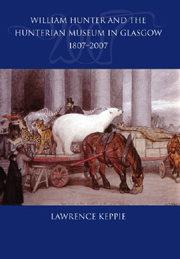Book contents
- Frontmatter
- Contents
- Foreword by Sir Kenneth Calman
- Introduction
- List of Illustrations
- Acknowledgements
- Abbreviations used in the Notes
- Dedication
- 1 William Hunter's Life and Career
- 2 Growth of the Hunterian Collection
- 3 ‘The Noblest Legacy upon Record’
- 4 A Temple of the Muses: the First Hunterian Museum in Glasgow
- 5 ‘This Place of Fascination’: the Impact of the Museum, 1807–70
- 6 A New Museum for a New University, 1870–1900
- 7 The Twentieth Century: War, Peace and Renewal, 1900–75
- 8 The Hunterian Art Gallery
- 9 Modern Times, 1975–2007
- 10 Overview: Meeting William Hunter's Intentions
- Postscript: Looking to the Future
- Notes
- Appendix: Catalogues of the Hunterian Collections
- Bibliography
- Index
- Plate section
10 - Overview: Meeting William Hunter's Intentions
Published online by Cambridge University Press: 12 September 2012
- Frontmatter
- Contents
- Foreword by Sir Kenneth Calman
- Introduction
- List of Illustrations
- Acknowledgements
- Abbreviations used in the Notes
- Dedication
- 1 William Hunter's Life and Career
- 2 Growth of the Hunterian Collection
- 3 ‘The Noblest Legacy upon Record’
- 4 A Temple of the Muses: the First Hunterian Museum in Glasgow
- 5 ‘This Place of Fascination’: the Impact of the Museum, 1807–70
- 6 A New Museum for a New University, 1870–1900
- 7 The Twentieth Century: War, Peace and Renewal, 1900–75
- 8 The Hunterian Art Gallery
- 9 Modern Times, 1975–2007
- 10 Overview: Meeting William Hunter's Intentions
- Postscript: Looking to the Future
- Notes
- Appendix: Catalogues of the Hunterian Collections
- Bibliography
- Index
- Plate section
Summary
William Hunter's principal aim in bequeathing his collection in 1783 had not been to provide the College at Glasgow with a museum, but to install a teaching resource as a stimulus to the medical curriculum, for which many of its sections were admirably suited. William made no specific statement in his will on how he expected individual parts of the collections to serve subsequent generations, but in the main he surely imagined their deployment as at Great Windmill Street, the anatomical and pathological specimens aiding the work of medical students, with the remainder assisting scholarly researchers, as they had during his lifetime (Figure 10.1). In general, this was how events turned out, though the Glasgow Trustees imposed increasingly restrictive conditions on who had access to what. Many of the sections, principally the coins and books, were felt over long periods to lack any educational value (see p. 90).
The Museum was at first received at the College with enthusiasm, but with the passage of time, and the death or retirement of the first generation of trustees, it came to be seen as an incubus, a drain on often straitened financial resources. There is a clear impression of stagnation by the mid-nineteenth century. After its seeming incarceration from 1870 in the new Gilmorehill complex, the Museum ceased to be a regular feature of travellers' accounts and from 1901 it was eclipsed by the competing attractions of the nearby Kelvingrove Museum and Art Gallery (see below).
- Type
- Chapter
- Information
- William Hunter and the Hunterian Museum in Glasgow 1807–2007 , pp. 132 - 135Publisher: Edinburgh University PressPrint publication year: 2007



